Latest Forum Topics /
GLD USD
Last:367.69
 -4.51
-4.51
|
|
|
Gold & metals
|
|
|
bsiong
Supreme |
08-Oct-2011 07:51
Yells: "The Greatest Wealth is Health" |
|
x 0
x 0 Alert Admin |
Ben Davies - Buy Gold, The Only Option Left is to Print MoneyWith gold still near $1,640 and silver at $31, today King World News interviewed Ben Davies, CEO of Hinde Capital, to get his take on the crisis in Europe and where the gold market is headed. When asked about the situation in Europe, Davies responded, “Mervyn King stated on the television the other night that he believes the the financial situation is far greater than what loomed in 2008. Of course he is going to say that because he just opened the monetary spigots, but he’s right. There is no doubt that what I think we are experiencing is potentially the death throes of fractional reserve banking.” Ben Davies continues:
“How many times have I come on, Eric, and we’ve talked about if it wasn’t so tragic you would just want to cry with laughter. I mean it really is a ridiculous state of affairs. This is where we’re left in the European zone. We are effectively going to try to create money out of thin air. Where are we going to get it from? Where does this end?
How are they going to recapitalize these banks is what I ask? Sadly I think it is going to come from the coffers of the ECB. At the end of the day the core is not actually strong enough with growth at these levels and the periphery has no money. So we are in that untenable situation where even the man on the street understands now, the only option left is to keep printing.
I think the debate was whether or not it was going to happen this month or next. In true Bank of England style they tend to slightly shock the market and they did 75 billion instead of 50 billion for the asset purchase facility. It makes me laugh when they say they can’t buy any bonds that are being issued for at least a week, i.e. they don’t want to be seen monetizing new issuance or deficit financing.... “But as I’ve explained on the show before, in order to have new issuance, they need to buy the existing bonds in the secondary market, which is what they are doing. No doubt, in some ways, what the Bank of England wants and what the government will want is to export their way out of this. But yes, it is more of the same, sadly.
At some point we have to talk about when easy money dies rather than when money dies. I really do believe we are going through the death throes of the fractional reserve system. What does that mean? We should all be in real assets, like gold.
There is not doubt that we saw a mass on mass deleveraging across all asset classes. When I see people who do not understand the gold market, one the concept of the two-tiered market and two, they don’t understand that gold is actually a form of money. I don’t think they realize also how much money is being put into the system.
To my mind gold will not be falling back to $1,400. I believe that we have (already) seen the low. We have seen open interest collapse dramatically. I believe it’s done.”
Davies was tremendous in his interview. He discussed how the ongoing crisis will be managed, where he sees gold and silver headed, along with the mining shares and much more. The KWN interview with Ben Davies will be available shortly and you can listen to it by CLICKING HERE.
|
| Useful To Me Not Useful To Me | |
|
bsiong
Supreme |
08-Oct-2011 07:37
Yells: "The Greatest Wealth is Health" |
|
x 0
x 0 Alert Admin |
Gold and silver, unlike paper money, never diegoldmoney.com But what does it matter, really? Gold and silver are not short-term investments. They are not get-rich-quick schemes – quite the opposite in fact. They are long-term hedges against both inflation and currency debasement. For centuries, gold and silver have been the ultimate store of value, and the truest forms of money. Simply put, they are worth their weight, and will bounce back strongly from their recent price setbacks. The reason why is because the long-term outlook for gold (and silver) is incredibly bullish. Our current financial and economic systems are both unsustainable and unsolvable. They are unsustainable because fiat-paper currency itself – the present monetary standard for the entire world – is a system based on faith and, once that faith is lost, so goes the value of that fiat-paper currency. They are unsolvable because our governments – especially in the United States and in Europe – refuse to accept the only two possibilities which remain: they can either a) admit that their fiat-paper currency system is solely based on faith (and then watch it all fall apart) or b) fail to admit that there is a problem with fiat-paper currency and continue to spend billions upon billions upon trillions (and then watch it fall apart). In either case, the end is the same: a worthless piece of paper. Option “b” seems to be the route our governments and central banks have chosen to take. For instance, in the United States, financial programmes like quantitative easing are just fancy names for plain and simple money printing, with the same policy also evident in Europe and Japan. In fact, it soon becomes evident in any country or region with a fiat currency that runs into serious debt issues. But for those who hold gold and silver, they need not worry about having faith or confidence. Why? Because they have something real. They have something which has been money for over 6,000 years. They have something which is virtually indestructible. They have something which can be easily divided and then those divisions exchanged for a variety of other real and tangible assets. They have something which nearly all persons, since Aristotle to President de Gaulle, have deemed valuable and true. They have gold. And in the long run, that’s counted for an awful lot.
|
| Useful To Me Not Useful To Me | |
|
|
|
|
bsiong
Supreme |
08-Oct-2011 07:35
Yells: "The Greatest Wealth is Health" |
|
x 0
x 0 Alert Admin |
Silver is as good as - or better than - goldthenational.ae And then, all of a sudden last month, gold experienced a 20 per cent drop. Some say it was just a technical readjustment, what traders call a " reversion to the mean" . Others point to the strength of the US dollar, which became increasingly attractive as the European debt crisis unfolded, causing a mass movement in its direction. Whatever the reasons, the drop caused some to question whether it's time to come off the gold fixation. It may come as a surprise to a financial public trained to monitor the price of gold that the stronger trade in recent times has been silver, or the " poor man's gold" , which has outperformed the yellow metal by a significant margin. Silver also took a beating late last month, even bigger than that experienced by gold, but that is not how it has played out for most of the past three years. If you take the global financial crisis as your starting point and then compare the prices of the two metals over that period, the so-called lesser metal has quadrupled in value compared with the mere doubling in the US dollar value of gold. David Land, the head of analysis at CMC Markets in Australia, says it is a surprise to see the exact movements of the two metals over this period. Gold, he says, has been such an important instrument in times of volatility that silver has been practically forgotten.
" Gold has always been the great hedge against fear, the hedge against a weakening US dollar and the hedge against inflation. If people are looking for a pure play against those factors, they're probably going for the gold option over silver," Mr Land says. The gold-silver ratio is one that has been around for some time and there are theories used by many to explain the relative movements between the two metals. The so-called standard gold-to-silver ratio has long been held at about 40 to 1 - that is, 40 ounces of silver will buy a single ounce of gold. Traditionally, the two metals are a well-correlated " pairs" trade, but things have changed. The value of an ounce of silver in October 2008 was US$9 (Dh33.06) to $10. In April this year, it nudged $50. In the same period, gold moved up from about $745 to a high of $1,920, a rise of about two and a half times. Silver prices have greatly outpaced gold - not just in this period, but for most of the past decade. Spot silver rose to an all-time high of $49.79 an ounce on April 25, a 12-fold advance from its low of $4.04 in 2001. The current ratio, with silver trading at close to $31 and gold at $1,652, is about 53, but it was at 65 at the time of the global financial crisis and at about 45 before the most recent price drops. Silver, at least over the past three years, has been the stronger commodity.
The way the silver-gold arbitrage works is fairly simple, but you have to have a relative view of which metal will surpass the other. Silver is arguably the more interesting metal because it is what traders and insiders term a " 50-50" asset. That is, it's 50 per cent a safe haven and 50 per cent a usable commodity. It has far more industrial uses than gold and thus its price is not solely dependent on its status as a safe haven from the US dollar. Silver offers exposure to economic recovery while retaining some safety aspects. It's used in a host of industrial applications, particularly in technology and photovoltaic applications, as well as for jewellery and coins. So any increase in global economic activity tends to swell its price.
|
| Useful To Me Not Useful To Me | |
|
bsiong
Supreme |
08-Oct-2011 07:32
Yells: "The Greatest Wealth is Health" |
|
x 0
x 0 Alert Admin |
The gold price went over $1,900 and looked as though it was going to mount $2,000, but since then has fallen back to $1,600 and is in the process of consolidating around the lower $1,600 area. It was expected that it would have moved a lot higher faster, but that hasn't happened, yet. In the face of Italy's downgrade to A2 by the ratings Agency, Moody's summary that, " There has been a profound loss of confidence in certain European sovereign debt markets, and Moody's considers that this extremely weak market sentiment will likely persist. It is no longer a temporary problem that might be addressed through liquidity support, and several euro-area governments are increasingly affected by the loss of confidence." The downgrading was expected, as are further downgrades for the different Eurozone members, shouldn't the gold price be on its way through $2,000 to much higher levels? The 'downturn' The news over the last few weeks has sent global financial markets down very heavily as a slow recovery morphed into a downturn and at best a flat economic future in the developed world. These falls have been accompanied by tremendous worries that there could be a major banking crisis that will cripple the Eurozone economy as a whole, not just the debt-distressed nations. In France growth is now at zero, in Greece it is somewhere south of a 5% dip in growth well into recession. Greater austerity simply adds to the fall in government revenues defeating their purpose of reducing their deficit. All of this implies an ongoing shrinkage of the Eurozone economy. This hurts investor capacities in all financial markets and wealth throughout the Eurozone. Cash becomes 'king' as investors flees markets to a holding position waiting for much cheaper prices before re-entering markets at lower levels. The path to deflation is then made. Deflation in its early stages causes tremendous de-leveraging. That is the selling of positions to pay off loans taken to increase positions. It may come about because of investor prudence, banks calling in loans, stop-loss triggers and margin calls [where the level of debt against positions becomes too high and forces sales]. This often and particularly in the case of precious metals has nothing to do with the fundamentals of the market. It is simply the position of investors. This happened in the precious metal markets as well. This is why gold and silver prices fell. De-leveraging As was the case in 2008 and often through history, the process of de-leveraging is a short-lived one, even when it is savage. Once and investor has sold the positions he feels he needs to that downward pressure on prices disappears. Leveraged positions are the most vulnerable of investor held positions and can make up the froth or 'surf' in the markets, which cause the volatility levels to increase when dramas strike. In 2008 these positions were huge because there had been two and a half decades of burgeoning markets that encouraged greater risk taking. Since then, while leveraging has taken place it has been less and rapidly removed when dramas hit. In 2008 we saw a similar drop in prices from $1,200 to $1,000 [20%], which equates to the fall from $1,910 to $1,590 [16.9%]. In 2008 the precious metal prices then slowly rose as buyers started to come in from all over the world. It took over a year for prices to recover back to $1,200. Change in market structure Today the shape of the precious metal markets is quite different, particularly that of gold. In 2008 central banks were sellers, today they are buyers. In 2008 the Chinese gold markets were small. Since then they have grown to such an extent that they are soon to overtake India. These are two dynamic features that give demand a totally different shape to 2008. More than that, the impact of the developed world long-term has diminished quite considerably. It now represents less than 21% of jewelry, bar and coin demand. The emerging world as a whole represents over 70% of such demand now. The bulk of the world's physical gold that comes to the market is dealt at the London twice daily Fixings. The balance that is traded outside the Fixings is the most short-term price influential amounts, producing the swings that resemble the waves on the seashore. It is these traders and speculators that often persuade long-term buyers to stand back and wait for the prices to swing to the point that persuades them to enter the market. The drop from $1,900 had this effect on investors. Now that the fall has happened we see a surge in demand from the emerging world to pick up the slack in the market. We have no doubt that central banks are buying the dips as well. So once the selling from the developed world has stopped [emerging market demand waits for this before buying, allowing the fall to extend further] in come the buyers happy that they are entering the market at a good time. Because of this change in market shape we fully expect the market to take far less time to find its balance and allow demand to dominate. 2012 recession and the battle against it The I.M.F. has just warned that the developed world will enter a recession in 2012. Will that be a negative for the gold market? We do not believe that it will. The world has seen the recovery peter out, has seen the sovereign debt crisis arrive and now sees the I.M.F. recommend that the Eurozone banks be recapitalized. What does this mean for precious metals? Cast you minds back to the recapitalization of U.S. banks under the TARP measures whereby the Fed bought the 'toxic' debt investments of the banks against fresh money. When we say fresh we mean just that, newly created money in the trillions. This did lower the perceived value of the dollar inside and outside the U.S. The effect on gold was palpable as it rose back through $1,200 and onto new highs. Already we are hearing rumors of an E.U. government minister's plan to walk the same or similar road. With the recent past in mind, we are certain that that will lower the perceived value of the euro and see euro investors seek places to cling onto the value the euro still has. This time round we fully expect markets to discount these actions in the same way. The downturn will therefore be fought with new money creation in the same way the U.S. did it from 2008 on. Second time round There is a significant difference between 2008 and now. In 2008 the credit crunch was new to investors and shocked the markets into overreactions. In 2011 we are not shock but expectant of what lies ahead. In 2008 the developed world economy had considerably more resilience than it does now, so the situation is more serious and less likely to be believed as the panacea for the developed world's economic crisis. Because the gold and silver prices rose so strongly after that time and in the face of those 'solutions' the same will be expected now. In 2008 confidence in the financial system as well as in the monetary system appeared unassailable, not this time. While the developed world, outside of the gold ETF's in the U.S., has not been the main driver of rising gold prices, this time we would not be surprised to see their resilient confidence in their world snap and a frantic search for safe-havens follow. Yes, if we see a repeat of the 2008 breakdowns in the near future they will slaughter remaining confidence in the monetary system and the ability of its governments to set matters straight. What then for gold and silver? |
| Useful To Me Not Useful To Me | |
|
bsiong
Supreme |
08-Oct-2011 07:22
Yells: "The Greatest Wealth is Health" |
|
x 0
x 0 Alert Admin |
 Gold will continue rising in value over the coming years for one reason: The primary buyers are purchasing physical gold for wealth preservation, and there simply isn't enough physical gold to satisfy their appetites. The recent pullback was by no means the bursting of the gold bubble. Bubbles are characterized by months of extended exuberance and consistently higher highs-not the two- and three- hundred-dollar corrections we've seen twice in the past few weeks. Such pullbacks are healthy as they indicate gold has much, much farther to go. Those who buy gold for wealth preservation are happy. Gold has outperformed all other asset classes for most of the past decade (Figure 1). As other asset classes, such as bonds, currencies and stocks, become more positively correlated to each other, gold continues moving in the opposite direction and therefore continues serving its true purpose of wealth preservation effectively. 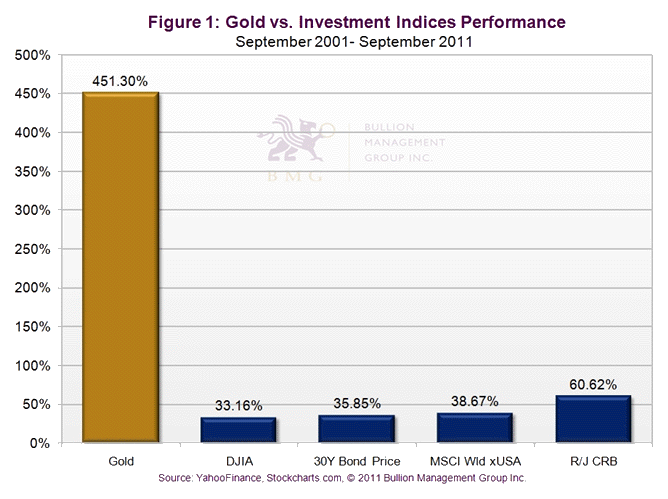 For the half of the world that will be responsible for gold's eventual five-digit destination-the Chinese, Russian, Middle Eastern and Indian buyers-gold is doing its job. They are far less concerned about short-term price swings. Their distrust of fiat currencies has not abated just because the US came up with yet another plan for extending the dollar's hegemony-the latest being an attempt to flatten the yield curve between long- and short-term bonds through the Fed's " Operation Twist." Many of these people remember how currency debasement can destroy wealth. The world's largest gold buyers, the Chinese, experienced hyperinflation between 1947 and 1949. This is still fresh in their minds. As the aging population, outsourcing and a variety of other irreversible trends converge, growth slows-yet growth is essential to our current economic structure, and currency must be created to compensate for this slowing growth. Ultimately, Western central bankers have no other choice but to continue printing currency and, through this act, debasing its value. Despite Federal Reserve Chairman Ben Bernanke's recent assurances that inflation will remain at two percent, real inflation, that which is determined by measuring the original basket of goods before they began substituting expensive items for cheaper ones, will continue growing. ShadowStats measures this original basket of goods and puts real inflation at about 11 percent. Inflation is caused by currency debasement. Gold is the best indicator of true inflation because there is a limited supply of it and more dollars/euros/pesos chasing the same limited supply makes gold appear to rise in price. As the gold holders of the East probably realize, gold is not really rising in value. It is holding its purchasing power much as it has for the past 3,000 years. Currencies are falling in purchasing power against gold. This implies that gold can rise as far as currencies can fall and, since there is no alternative but to continue printing currency to compensate for slowing growth and rising entitlement payments, gold is destined to rise much higher for many years to come. Gold will continue to rise until the economy is truly healthy again. Talk of deflationary pressures reversing the course of gold is a short-term, Western assessment. Of course, as we've recently seen, when the stock market crashes people sell their winners to cover margin, and lately the big winner has been gold. Last week the gold market saw stop losses, margin calls, raised margin requirements and a rising dollar, so the computers that do most of the trading these days sold on overdrive. The Eastern buyers, as well as sophisticated Western investors, are happy with pullbacks as they allow them to buy more gold at attractive prices. The Chinese Central Bank has publicly stated that it plans to raise reserves from 1,100 to 6,000 tonnes of gold. Unofficially, they have stated 10,000 tonnes. They think in terms of decades, not nanoseconds like Western speculators. The Chinese government encourages its citizens to put five percent of their savings in gold. They are developing infrastructure to make gold ownership as easy as possible and to make the country the most gold-mining-friendly country in the world. In fact, they now lead the world in gold production. For those who like to compare our current gold market with that of the late 1970s it is well to remember that the Chinese, and most of today's developing countries, were not even participants at that time. Perhaps the most significant development of the past decade, and one that has gone virtually unnoticed in the West, is the Pan Asian Gold Exchange (PAGE) to be hosted in Kunming City, Yunman Province - the gateway to all of Southeast Asia. This is a game-changing event that is part of China's five-year plan to change the entire face of the gold market. In the west, 100 ounces of paper gold are traded for every ounce of physical. The PAGE will be the polar opposite of this. It will have a 1:1 leverage rate between the renminbi and gold. This perhaps reflects the Chinese distrust of gold derivatives and paper currencies. In a recent Forbes article , titled " The Chinese Mean To Control The Global Gold Market," author Robert Lenzner makes the point that this is the plan. Of course, gold has a long history of moving to where things are made and, like Western manufacturing jobs, gold is moving east. The PAGE is scheduled to open to the 320 million customers of the Chinese Agricultural Bank late this year and to the rest of the world in 2012. As it does, the PAGE will appeal to gold buyers who prefer to trade in a liquid physical market over a paper market. It will increase the demand for physical gold exponentially. Confidence in paper products is rapidly waning. Easterners are simply further ahead of the West on this as they have more recent memories of the destruction currency devaluations can cause. At BMG we encourage our customers to think outside the box of this Western-centric fiat thinking and to assume the broader, value-based perspective that gold affords, one that many Easterners have already embraced. We encourage our customers to think in terms of ounces not dollars. This is of course much easier to do when you own physical bullion. Such a vantage point helps to put these pullbacks in perspective. When gold corrects, buy more. When it resumes its long multi-year ascent, be grateful you did.
|
| Useful To Me Not Useful To Me | |
|
|
|
|
bsiong
Supreme |
08-Oct-2011 07:18
Yells: "The Greatest Wealth is Health" |
|
x 0
x 0 Alert Admin |
Gold's New Volatility In Pictures
Adrian Ash
BullionVault.com 6 October 2011 ONLY 12 MONTHS AGO, the gold price was so placid - quietly making new record highs above $1300 and then $1400 per ounce - that volatility in its daily swings hit the lowest level in half-a-decade. Hardly the stuff of mania. And it only made buying gold a simpler decision for new and existing investors, especially those borrowing money to do it on the derivatives market. Whereas this summer's surge to (and sharp drop from) $1920 an ounce has already thrown a fat chunk of " hot money" out of the trade. 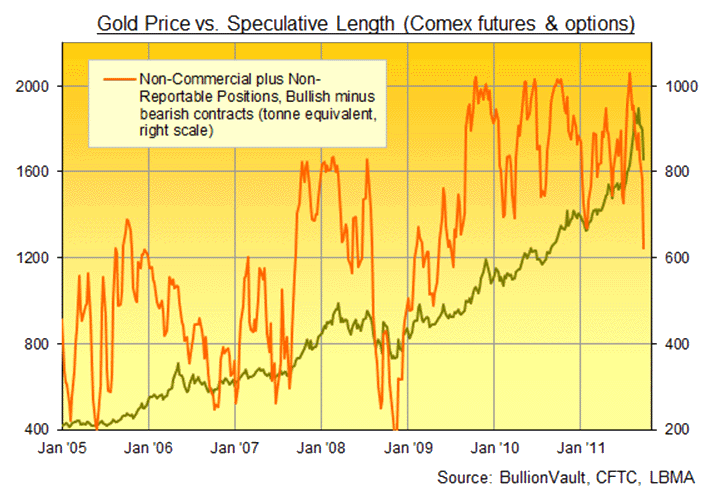 As you can see, leveraged speculators are fleeing the gold futures and options market at the fastest pace since Lehman Brothers blew up in Sept. 2008. Already shrinking by 40% since the new record peak of start-August, their " net long" betting on gold prices (simply the number of bullish minus bearish contracts) has crashed to barely 600 tonnes equivalent - the smallest level since mid-2009, and a level first reached at the tail-end of 2005. Now, whichever came first - chicken or egg, price drop or hot-money flight - the end result so far this autumn is a jump in price volatility last seen at (you guessed it) Lehman Brothers' collapse. 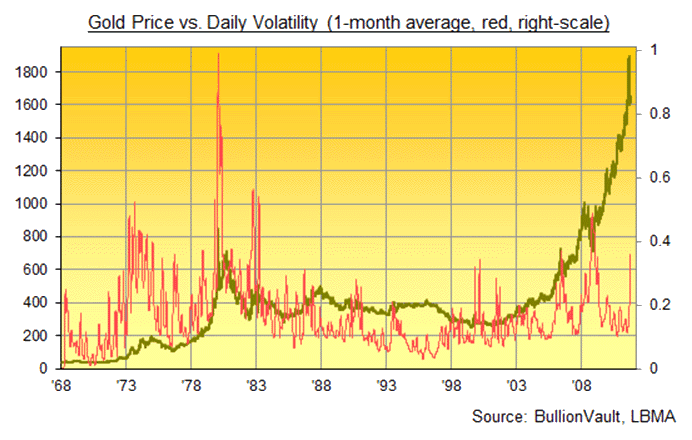 " Key characteristics of a safe-haven asset are low price volatility and minimal risk of capital loss," notes the latest Commodities Weekly from French investment bank and bullion dealer Natixis. " With gold price volatility doubling, and gold prices dropping by more than 10% in just three days [last week], these characteristics no longer apply to gold." But this loss of what was apparently gold's " safe haven" status hasn't diminished demand. Quite the contrary in fact for physical gold buyers, both in Europe and the US but more critically in the world's No.2 consumer - and fastest-growing source of demand - China. Reports from bullion bank and secure logistics contacts all point to a surge in gold buying from Asia, with large 400-ounce bars being sucked out of London for turning into kilo-bars in Switzerland to be shipped onto China. Price volatility still applies, however. With bells on. 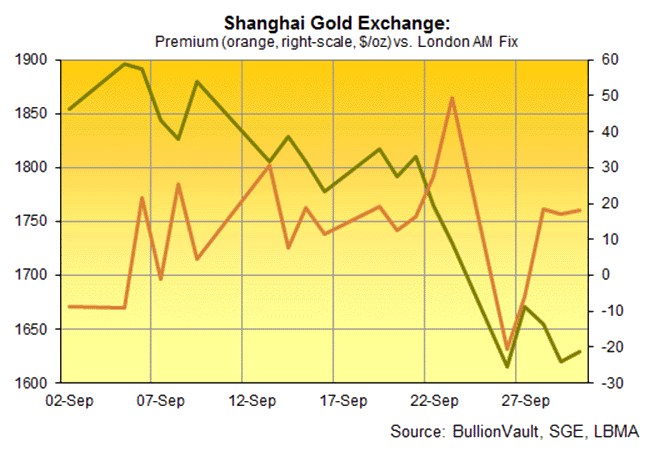 If you've struggled over the last month with gold's new volatility, then pity buyers and sellers on the Shanghai Gold Exchange. Violence in the domestic Chinese gold price has been worse by one fifth than in US Dollar prices on the London Fix - still the global benchmark price almost 100 years after the end of Great Britain's imperial gold standard. That's because London is still central clearing for the vast bulk of the world's gold, where it sits ready for shipping wherever else it will find a use. Increasingly, that somewhere else is China, even though it's now the world's No.1 mining producer each year. Chinese refineries lead new applications to produce London Good Delivery bars, the 400-ounce wholesale standard worldwide. Yet no Chinese-made bars should (as yet) have reached London's Good Delivery bullion vaults, despite their producers devoting themselves to gaining LGD accreditation. Because China's borders are closed to exports of gold. This one-way traffic - into China - helped last year to plug the 360-tonne gap between China's world-beating mine output and it's galloping demand for gold. The huge volatility in Shanghai premiums over London gold is of course a function of the metal's underlying volatility. But it's clearly being extended by the logistical bottlenecks and delays that are guaranteed to hit this very physical trade, now trying to ship ever-more gold bullion from the other side of the world. Adrian Ash BullionVault Formerly City correspondent for The Daily Reckoning in London and head of editorial at the UK's leading financial advisory for private investors, Adrian Ash is the editor of Gold News and head of research at BullionVault - winner of the Queen's Award for Enterprise Innovation, 2009 and now backed by the mining-sector's World Gold Council research body - where you can buy gold today vaulted in Zurich on $3 spreads and 0.8% dealing fees. (c) BullionVault 2011 Please Note: This article is to inform your thinking, not lead it. Only you can decide the best place for your money, and any decision you make will put your money at risk. Information or data included here may have already been overtaken by events - and must be verified elsewhere - should you choose to act on it. |
| Useful To Me Not Useful To Me | |
|
bsiong
Supreme |
08-Oct-2011 07:11
Yells: "The Greatest Wealth is Health" |
|
x 0
x 0 Alert Admin |
Gold, silver end lower, break 4-week losing streakNEW YORK (Oct 7) Gold futures ended lower Friday, snapping a two-day winning streak as investors shied away from the metal amid a lack of catalysts to spur flight-to-safety buying.Commodities and stocks got an early a boost from a better-than-expected report on the U.S. job market, but that lift was short-lived as traders looked closer at the numbers.Debt downgrades for Italy and Spain brought back fears about Europe’s sovereign-debt crisis, but the news, coming late in gold’s session, failed to boost bullion prices.Gold for December delivery lost $17.40, or 1.1% to $1,635.80 an ounce on the Comex division of the New York Mercantile Exchange. On the week, however, gold gained 0.8%, which snapped a four-week losing streak for the metal.Other metals ended the day mostly lower, with silver leading losses. Copper bucked the trend, however, ending higher.December silver declined $1.01, or 3.2%, to $30.99 an ounce. On the week, silver rose 3%, also breaking away with losses in the four previous weeks.Copper for December delivery added 3 cents, or 0.8%, to end at $3.27 a pound. Weekly gains for copper reached 3.8%. Like silver and gold’s weekly gain, copper’s snapped losses for four weeks in a row.Gold and most commodities have been trading sideways in recent sessions.“There hasn’t really been a catalyst” to push gold higher, but the lingering concerns about the euro-zone sovereign-debt crisis and a weaker dollar provide a floor for prices, said Matt Zeman, a senior market analyst with Kingsview Financial in Chicago.Earlier Friday, the Labor Department said the U.S. added 103,000 nonfarm jobs in September.The increase was larger than the 59,000 gain expected by Wall Street economists polled by MarketWatch. Read more on jobs report.A closer look, however, shows much of the gains reflected workers coming back from a strike, Zeman said. “The number was not as good as it was at first glance,” he said.“Gold will continue to outperform silver in an environment in which Western world growth is under attack,” Deutsche Bank analyst Adam Sieminski said in a note to clients.Deutsche Bank economists had expected a 70,000 rise in payrolls, which would indicate a slowdown, but not a recession.Platinum and palladium joined silver and gold lower. January platinum lost $14.80, or 1%, to $1,493.30 an ounce. December palladium declined $12.95, or 2.2%, to $585.85 an ounce.On the week, palladium lost 4.7% and platinum 1.7% |
| Useful To Me Not Useful To Me | |
|
bsiong
Supreme |
08-Oct-2011 07:08
Yells: "The Greatest Wealth is Health" |
|
x 0
x 0 Alert Admin |
Closing Gold & Silver Market Report – 10/7/2011
October 7, 2011
Europe Remains the Driving Force Behind the Markets Precious metals prices rose higher in afternoon trading, but still fell for the day. Both the U.S. stock and global precious metals markets rose on the mornings jobs announcement, but fell as the news became more fully digested. We did see an increase of 103,000 jobs, but 45,000 of these were Verizon workers coming off their strike. Government workers, (federal,city and state) were big losers and this is expected to continue. More negative news out of Europe did nothing to enhance investor’s moods. Fitch downgraded Italy and Spain’s debt rating, and just now a story is breaking that Belgium’s rating is going under review by Moody’s. You know things are not good when the debate amongst economist is whether we are going to experience the “Great Depression” of the 1930’s or the “Long Depression” of the 1870’s. This interesting article published by Reuters is food for thought as we go into the weekend. Please enjoy yours!
At 3:42 PM (CT) the APMEX precious metals spot prices were:
|
| Useful To Me Not Useful To Me | |
|
|
|
|
bsiong
Supreme |
08-Oct-2011 01:17
Yells: "The Greatest Wealth is Health" |
|
x 0
x 0 Alert Admin |
2005 YU55 asteroid will sweep near Earth November 8, 2011 |
| Useful To Me Not Useful To Me | |
|
bsiong
Supreme |
08-Oct-2011 00:25
Yells: "The Greatest Wealth is Health" |
|
x 0
x 0 Alert Admin |
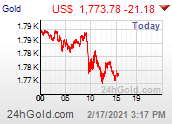 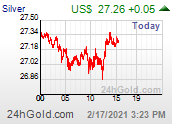 |
| Useful To Me Not Useful To Me | |
|
bsiong
Supreme |
08-Oct-2011 00:14
Yells: "The Greatest Wealth is Health" |
|
x 0
x 0 Alert Admin |

|
| Useful To Me Not Useful To Me | |
|
bsiong
Supreme |
08-Oct-2011 00:09
Yells: "The Greatest Wealth is Health" |
|
x 0
x 0 Alert Admin |
Gold prices spurred higher by more QEgoldmoney.com |
| Useful To Me Not Useful To Me | |
|
|
|
|
bsiong
Supreme |
07-Oct-2011 23:59
Yells: "The Greatest Wealth is Health" |
|
x 0
x 0 Alert Admin |
Morning Gold & Silver Market Report – 10/7/2011October 7, 2011 JOBS REPORT BETTER, NOT ENOUGH TO MAKE A DENT IN UNEMPLOYMENT In overnight trading, gold reached as high as $1,669, and is currently resting slightly lower than that after the release of the U.S. jobs report from September. The report showed that 103,000 jobs were added in September, about 44,000 more than expected. The unemployment rate, however, was unchanged at 9.1%, and to maintain that rate, 125,000 jobs need to be added month-to-month. So, although today’s news was good news, it’s still not what’s needed to reduce the rate. Stock futures started low, but turned higher after the report. Former Federal Reserve Chairman Alan Greenspan said recently regarding the European debt crisis: “I think it’s very dangerous. Everyone’s got their fingers crossed.” When questioned about the threat of the contagion in Europe reaching American shores, Greenspan said, “This is an integrated system. The presumption that somehow the huge American banking system … is independent of Europe is, I think, just utterly unrealistic. It looks independent until it isn’t.” The situation in Syria has not improved, and now the government is pointing the blame at foreign powers. Deputy Foreign Minister Faisal Mekdad said that over 1,100 security personnel have been killed in the situation, and accused the media of creating a propaganda war against President Bashar al-Assad’s rule. The statements were given in front of the U.N. Human Rights Council, where envoys from Britain, France, and the U.S. called on Syria to halt executions, arbitrary detentions, torture, and enforced disappearances of civilians. At 8:06 am (CT) the APMEX precious metals spot prices were:
|
| Useful To Me Not Useful To Me | |
|
bsiong
Supreme |
07-Oct-2011 23:44
Yells: "The Greatest Wealth is Health" |
|
x 0
x 0 Alert Admin |
Moody's downgrades 12 UK financial institutionsIndia Infoline News Service / 12:42 , Oct 07, 2011 This concludes its review of systemic support assumptions from the UK government for these institutions initiated on May 24. Moody's Investors Service on Friday downgraded the senior debt and deposit ratings of 12 UK financial institutions and confirmed the ratings of one institution. This concludes its review of systemic support assumptions from the UK government for these institutions initiated on May 24. The downgrades have been caused by Moody's reassessment of the support environment in the UK which has resulted in the removal of systemic support for 7 smaller institutions and the reduction of systemic support by one to three notches for 5 larger, more systemically important financial institutions. According to Moody's, announcements made, as well as actions already taken by UK authorities have significantly reduced the predictability of support over the medium to long-term. Moody's believes that the UK government is likely to continue to provide some level of support to systemically important financial institutions, which continue to incorporate up to three notches of uplift. However, it is more likely now to allow smaller institutions to fail if they become financially troubled. The downgrades do not reflect a deterioration in the financial strength of the banking system or that of the government. In addition, the rating agency has assigned a negative outlook to the senior debt and deposit ratings of the banks that still incorporate two or more notches of systemic support, to reflect the likelihood of a further reduction in the availability of systemic support over the medium to long term. The rating actions include a one-notch downgrade of Lloyds TSB Bank plc (to A1 from Aa3), Santander UK plc (to A1 from Aa3), Co-Operative Bank plc (to A3 from A2), a two-notch downgrade of RBS plc (to A2 from Aa3) and Nationwide Building Society (to A2 from Aa3) and downgrades of one to five notches of 7 smaller building societies. The ratings of Clydesdale Bank were confirmed at A2 (negative outlook). As outlined in the May press release, Moody's has reviewed the standalone ratings of all entities prior to concluding on the debt ratings. A separate announcement today covers the upgrade of the standalone rating of Co-Operative Bank to C- (mapping to Baa1 on the long-term debt scale) from D+ and earlier announcements cover the upgrades of the standalone ratings of Santander UK, Nationwide, Yorkshire, and Principality Building Societies |
| Useful To Me Not Useful To Me | |
|
bsiong
Supreme |
07-Oct-2011 12:55
Yells: "The Greatest Wealth is Health" |
|
x 0
x 0 Alert Admin |
Gold Inches Higher In Early Asian TradeSINGAPORE (Oct 7) Gold futures traded fractionally higher in Asian trade Friday, as European finance officials moved to stabilize the region’s banks and ease market concerns over euro-zone sovereign debt woes. On the Comex division of the New York Mercantile Exchange, gold futures for December delivery traded at USD1,653.75 a troy ounce during early Asian trade, adding 0.02%, after hitting a low of USDS1,652.05. European Central Bank President Jean-Claude Trichet said Thursday the ECB would begin a two-fold program to ease concerns in financial markets over Europe’s sovereign debt threats.Trichet, whose term as head of Europe’s central bank expires at the end of October, said the ECB would begin buying USD53 billion in covered bonds and institute longer term refinancing operations to commercials banks in the euro-zone beginning this month.The ECB voted to maintain interest rates unchanged at 1.5%.Earlier Thursday, the U.S. Department of Labor reported that the number of Americans filing for initial jobless benefits for the week ending September 30 rose by 6,000, to a seasonally adjusted 401,000.Market expectations were for jobless claims to rise to 411,000 after hitting 395,000 the previous week.The encouraging labor numbers lifted Wall Street shares, with the Dow Jones Industrial Average adding 1.68% to 11,123.33, the Nasdaq Composite Index rose 1.88% to 2,506.82, and the S& P 500 was lifted 1.83% to end the day at 1,164.97.The Bank of England also decided to leave interest rates at a record low 0.5%, a rate it has stuck to since March 2009, and increase the size of its own asset purchase program by USD115 billion. Elsewhere, German financial services provider Commerzbank, commenting on the BOE and ECB announcements, said “Such monetary easing is bullish for precious metals, especially gold, given their close relationship with global liquidity.” On the Comex, silver for December delivery dropped 0.41% to trade at USD31.87 a troy ounce, while copper for December delivery fell fractionally by 0.07% to trade at USD3.269 a pound. |
| Useful To Me Not Useful To Me | |
|
bsiong
Supreme |
07-Oct-2011 12:52
Yells: "The Greatest Wealth is Health" |
|
x 0
x 0 Alert Admin |
FINANCIAL CRISIS 'WORST WORLD HAS EVER FACED'telegraph.co.uk IT'S OFFICIAL: Housing bust worst since Great Depression...Nearly Half of U.S. Lives in Household Receiving Government Benefitwsj.com
|
| Useful To Me Not Useful To Me | |
|
bsiong
Supreme |
07-Oct-2011 10:33
Yells: "The Greatest Wealth is Health" |
|
x 0
x 0 Alert Admin |
  |
| Useful To Me Not Useful To Me | |
|
bsiong
Supreme |
07-Oct-2011 10:30
Yells: "The Greatest Wealth is Health" |
|
x 0
x 0 Alert Admin |
October 06, 2011 • 14:24:33 PDTJohn Hathaway - Bank Failures Moving Gold, This Is ContagionEurope is going to print the euro and we are going to print the dollar. We had a bank go down today and France is making contingency plans... Read More |
| Useful To Me Not Useful To Me | |
|
bsiong
Supreme |
07-Oct-2011 10:08
Yells: "The Greatest Wealth is Health" |
|
x 0
x 0 Alert Admin |
NEW YORK/LONDON | (Reuters) - Gold rose in thin trade for a second session on Thursday, boosted by a rally in equities and commodities after new liquidity measures from the European Central Bank fueled economic optimism. Silver jumped more than 5 percent, rising in tandem with industrial commodities led by copper and crude oil, as encouraging U.S. jobless claims data triggered gains across the board ahead of Friday's key nonfarm payrolls report. This week, the safe-haven buying that helped bullion log a three-year rally was largely absent, and neither did the metal trade consistently with risk assets, underscoring investors' confusion about the role of gold in financial markets. Gold prices traditionally rise in times of economic uncertainty. " I really don't see the safe-haven attraction of gold is going to change very much because of all the financial problems in Europe and in the western world," said Leo Larkin, metals equity analyst at Standard & Poor's. " There is still a lack of confidence in financial assets." Spot gold was up 0.6 percent at $1,651 an ounce by 2:41 p.m. EDT. Silver rose 4.8 percent to $31.84 an ounce, its biggest one-day gain in nearly two months. Bullion has ended higher in five of its last six sessions, on track to post its first weekly rise in the past five weeks. U.S. gold futures for December delivery settled up $11.60 at $1,653.20 an ounce. U.S. COMEX futures' trading volume was thin for a second straight day at about 55 percent below its 30-day average, set to be the weakest since June, Reuters preliminary data showed. Recent low turnover suggests bullion's gains of about 2 percent so far this week might be short-lived. " Continued uncertainty and choppiness in the metal's prices have discouraged traders from participating in gold," FC Stone commodity broker George Nickas said. Nickas said Friday's employment report could confirm the more positive tone in the stock market this week, which in turn may give bullion a firmer direction. Economists expect September U.S. nonfarm payrolls to have risen by 60,000 jobs, after a flat reading for in August. GOLD UP ON EUROPE HOPES Wall Street rose for a third day after the European Union's executive arm said it would present a plan for member states to coordinate a recapitalization of their banks, as regulators met to reassess the capital buffers of stressed lenders. Gold benefited on inflation concerns after the ECB threw a lifeline to commercial banks by turning up its liquidity pumps to provide longer-term cheap money for the growing number of European lenders. The moves came amid growing fears that Greece may be forced to default within months, setting off a chain reaction of sovereign downgrades and bank failures. Earlier this week, mounting debt fears dragged on stock markets, which prompted investors to sell gold to cover losses elsewhere. Gold recorded its biggest decline in nearly three years last month as selling to cover heavy stock market losses pulled prices more than 20 percent from record highs and prompted a period of intense volatility. Platinum group metals rose on the back of a 5-percent rally in copper. Spot platinum gained 1.7 percent at $1,510.74 an ounce, while spot palladium added 5.4 percent at $601.22 an ounce. |
| Useful To Me Not Useful To Me | |
|
bsiong
Supreme |
07-Oct-2011 10:04
Yells: "The Greatest Wealth is Health" |
|
x 0
x 0 Alert Admin |
|
| Useful To Me Not Useful To Me | |


